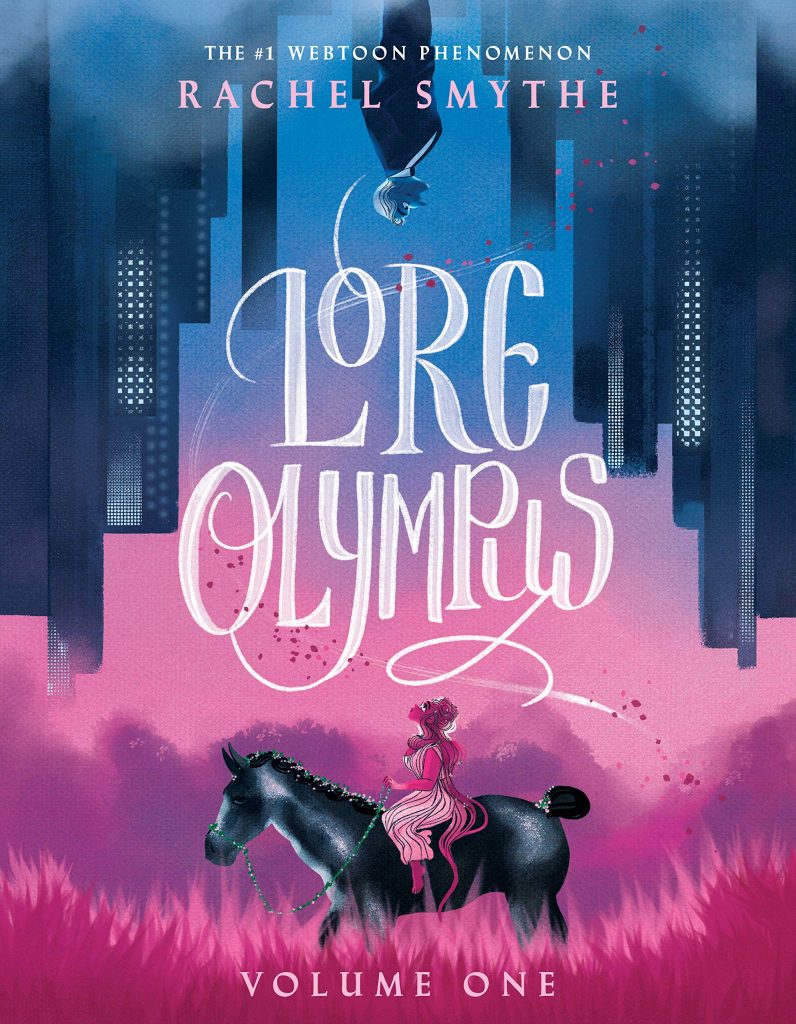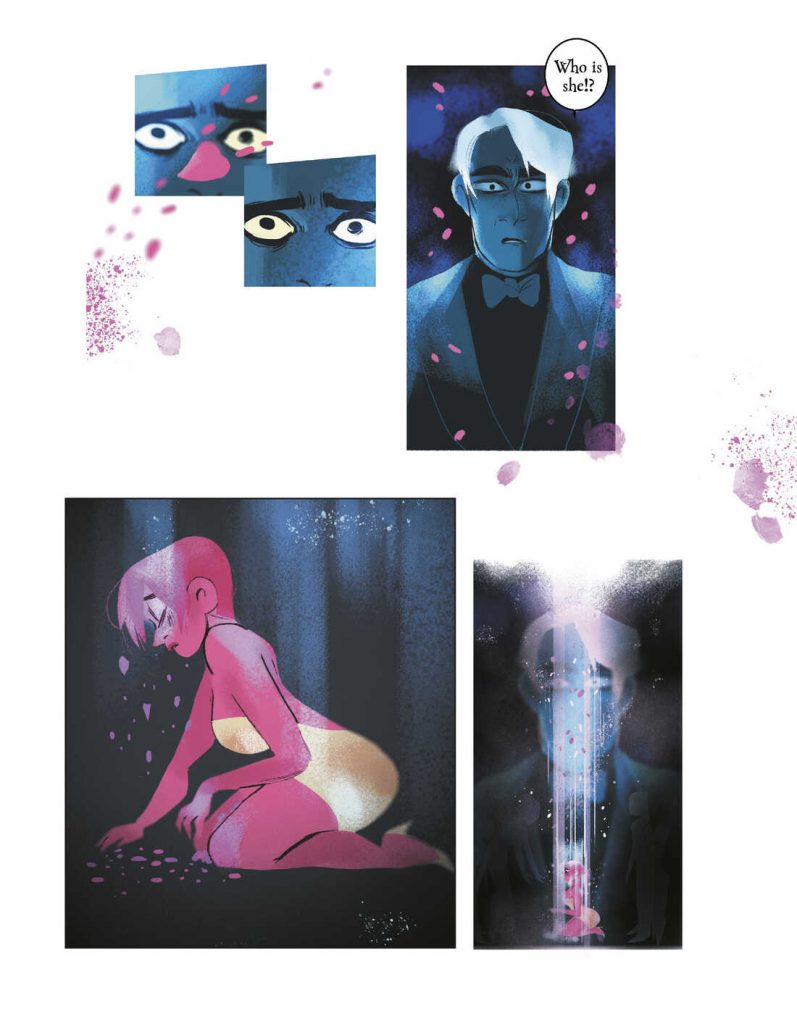“Witness what the gods do…after dark. The friendships and the lies, the gossip and the wild parties, and of course, forbidden love. Because it turns out, the gods aren’t so different from us after all, especially when it comes to their problems. Stylish and immersive, this is one of mythology’s greatest stories — The Taking of Persephone — as it’s never been told before.”
TW: sexual assault, domestic violence
Reader, meet Persephone: she’s the goddess of spring, an eternal maiden, and the “personification of a friggin’ cinnamon roll.” Persephone, meet Hades: God/CEO of the Underworld with seven dogs and 2,000 years’ worth of baggage. This is Rachel Smythe’s take on the famous god and goddess of the Greco-Roman pantheon whose divine romance, in her comic Lore Olympus, she doesn’t retell, but rather reinvents.
Lore Olympus is immensely popular. The series’ first episode was published online on Webtoonz on March 4, 2018. Since then, now at its 188th installment, it has garnered 968.1 million views—the number one most popular comic on the site. Smythe’s project, though featured as a Romance, hosts a wide ranging cast aside from Persephone and Hades (the main love interests) and explores a variety of subplots. Within the wide scope of her worldbuilding, there is something charming for each reader. So, when the first 25 episodes came out in print this past November, I was unsurprised to see legions of glossy paperbacks canvasing the shelves of my local bookstore, luring new and old fans alike with colourful pages begging to be flipped open.

Like the vibrancy with which Smythe renders her illustrations, the book’s characters, dialogue, and storylines are lurid and exciting. Crass language and obscenities abound—so do boobs. Everything is loud and exaggerated, a characteristic of the comic book genre that suits its subject material. If the gods are like us, they are also larger than life: true love, bitchiness, childhood trauma—Lore Olympus takes these modern experiences to divine dimensions.
Smythe is not very interested in plausibility, but certainly in style. Modern and antiquated elements lie side by side on the page, and though this fusion rarely makes sense, it doesn’t need to. Aimed more towards the maturing generation raised on Percy Jackson than dedicated Classics scholars, Lore Olympus explores personal subjects—particularly relationship challenges—through beautiful illustrations and a sense of fun. In a mini retelling of Cupid (Greek-ified as Eros) and Psyche, past and present collide. After sipping cocktails with Aphrodite on a rooftop patio, Eros zips into the mortal realm, donning hoplite-esque armour and a helmet that befits a Homeric hero. He rescues Psyche from an ornately-columned Greek home to his own modern condo. Despite the temporal confusion, the striking opulence of Smythe’s artwork—here, layers of bronzy pink burnish a black background—accentuates both the lovers’ intimacy and Psyche’s struggle to trust that Eros’ love for her is sincere. Smythe intuits that just as the past (in the form of inherited mythological figures) can exist in the present, the anxieties of the average 21st-century individual can belong in the literature of antiquity.
What elevates Lore Olympus from a soap opera or a romantic comedy to something more memorable is Smythe’s imaginative characters. Of the men, Hades is my favourite. It’s hard not to root for the god of death who—despite being the incarnation of Mr. Darcy with crisply-pressed suits, a sharp-nosed profile, and a (literally) godly physique—stumbles awkwardly through life. “Salutations. Hades here, I’m indisposed,” his voicemail begins. This immortal still has a chequebook because he “enjoys balancing it.” But even at 2,000 years of age, Hades struggles with self-worth. As Zeus points out, Hades is willing to settle for ‘okay’ when he could have ‘excellent.’ Smythe asks the right questions of these myths: what kind of trauma would the son of a father who ate his children have? For bad-tempered critics who may complain that Hades is just another ideal dreamt up by the female psyche—tall, dark, and handsome with a touch of woundedness—Eros and Apollo represent interesting counterparts. Eros is not quite the macho god of love we expect. This yacht-club jock (complete with a salmon-coloured sweater draped around his shoulders and an Elvis Presley haircut) apologizes to Persephone of his own accord, unmotivated by self-interest. This is the model of masculinity we need: a man who admits he’s wrong. Apollo, on the other hand, is the douche whom everyone can spot from miles away—except, as the story often goes, his next victim.

Writing a comic with trigger warnings is an ambitious task. In Lore Olympus, Smythe presents adapted, but uncensored Greek myth with all its ugly displays of violence (though I’m sure most of us are thankful that Smythe chose to skip the incest). Lore Olympus doesn’t wallow in exaggerated emotion, the kind which detracts from the significance of experiences such as sexual assault or domestic abuse. Instead, characters walk through reality as it is: messy, confusing, full of grey areas. Why would someone, even as they say that they love you, hurt you? Questions like these, as Smythe recognizes, do not merit simple, stereotyped answers. She allows her characters to struggle, and through this nuance, the plot becomes striking because it is so realistic. Not all assault involves physical violence. Not all rapists are old, greasy predators, strangers surging from dark corners of back alleyways. In Lore Olympus, Smythe doesn’t write to take a stance or to adjudicate the morality of the past; she shares human stories which are personal, compelling, and real.
Lore Olympus in print, however, is limited by its media. As much as my strained, screen-glued eyes appreciate reading printed pages, Webtoonz’s unique layout—which requires readers to scroll through vertical artwork—is poorly adapted to a book’s left-to-right format. Smythe’s digital art doesn’t pop with quite the same force on paper as on a glowing, pixelated screen. Further, because the opening installment only presents the series’ first 25 episodes, many plot threads are left hanging at its end. Lore Olympus’ TV-style narration, whose crisscrossing plotlines and large cast of characters sustain the audience’s interests over such a lengthy project, doesn’t quite work in stand-alone volumes. Fans will have to decide for themselves if the glossy paperback—and the three or more others likely to follow—is worth the $35 price tag. For me, I’m content with the online version; I prefer to invest in books which, unlike Lore Olympus, whose thrill lies largely in discovery, I will return to more than once or twice.
In Lore Olympus, you may not find genius (after all, Greek mythology has been in, as Esmé Squalor of The Series of Unfortunate Events would put it, for a few thousand years), but you will meet charming characters in a witty, appealing story. Smythe invites her reader to laugh, cry, roll her eyes, and think—all without taking herself or her work too seriously. Watch her take the Greek gods to therapy in style: the past is just as messed up as the present after all, just in different colours.
